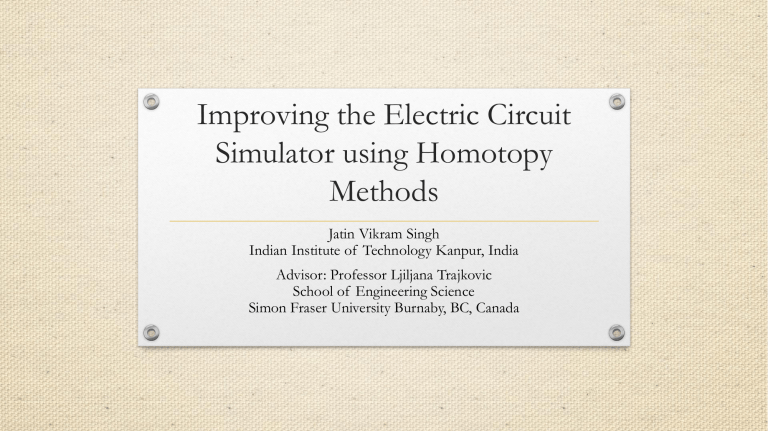Improving the Electric Circuit Simulator using Homotopy Methods

Improving the Electric Circuit
Simulator using Homotopy
Methods
Jatin Vikram Singh
Indian Institute of Technology Kanpur, India
Advisor: Professor Ljiljana Trajkovic
School of Engineering Science
Simon Fraser University Burnaby, BC, Canada
Outline
• Why Simulate!!!
• DC Operating Points
• Homotopy Methods
• Modified Nodal Analysis
• The Parser : Platform Change and Improvements
• Conclusion
Why Simulate!!!
• Understand principles of system
• Propose solutions to problems
• Vary the model to meet demands as required
• Saves us a lot of resources required to build these devices and money as well
DC Operating Points
• Also known as Bias Points or quiescent points, are the values of voltages and currents in the DC state for the devices.
• Transistors behave differently under AC and DC sources.
Homotopy Methods
• A numerical method used to find zeros of a system of equations.
• Create a simpler problem and then deform this problem into the original one.
• A series of zeros is computed from the simple problem until we find the solutions for the problem of interest.
Homotopy Methods
• Given a system of equations : 𝐹 𝑥 = 0
• Generate a new function called Homotopy Function : 𝐻 𝑥, λ = 0
• Varying λ from 0 to 1 varies homotopy function from a Gleek function
G 𝑥 to the original function 𝐹 𝑥 such that 𝐻 𝑥, 0 = G 𝑥 and
𝐻 𝑥, 1 = 𝐹 𝑥 .
• E.g. : 𝐻 𝑥, λ = G 𝑥 1 − λ + λ𝐹 𝑥 where G 𝑥 could be (𝑥 − 𝑎)
Homotopy Methods
• The objective is to find the set : 𝐻 −1 0 = 𝑥, λ 𝐻 𝑥, λ = 0}
• Inside this set we hope to find a continuous path which connects zeros of
𝐻 𝑥, 0 = 𝐺 𝑥 to 𝐻 𝑥, 1 = 𝐹(𝑥) .
• To trace the curve, we differentiate the homotopy function with respect to 𝑥 and λ to create a set of differential equations.
• These equations are then solved numerically to get the solution, DC operating points to the circuit.
Modified Nodal Analysis
• MNA often results in larger systems of equations than the other methods, but is easier to implement algorithmically on a computer which is a substantial advantage for automated solution.
•
To use modified nodal analysis one equation for each node not attached to a voltage source is written (as in standard nodal analysis), and then these equations are augmented with an equation for each voltage source.
• In the figure next slide, first six equations are standard nodal analysis and the rest are additional equations to balance the number of unknowns and equations
Modified Nodal Analysis
The Parser
• The parser is a C++ program that takes a SPICE Netlist file as input and returns Modified Nodal
Equations and Jacobians.
• This output is then used by a
Matlab script to apply homotopy and find the DC operating points of the circuit.
Spice Netlist File
The Parser : Platform change
Visual Studio
The Parser : Improvements
Datum Node
• Node with maximum number of connections.
• Ground node made the datum.
• Making ground as datum fixed many equations and Jacobian errors.
Nodal and MNA Equations
• Equations for some nodes had missing node voltages.
• Changing Datum node and fixing the equation printing module.
The Parser : Improvements
Equation Numbering
• Initially equations were being numbered by the node numbers, this caused repetition.
• They have been modified to be numbered consecutively, keeping the variables in the equations same as before.
Jacobian
• The Jacobians adjusted after the systematic numbering of equations and changing the datum node.
• Repetitions in some Jacobian values were removed by making some modifications in the code.
Conclusion
The output file is the standard format to be used by the Matlab code to employ homotopy on the circuit equations to evaluate the DC operating points. The output files have been attached along with this presentation.
Modified Nodal Analysis Equations and Jacobians
Schmidt Trigger
Chua’s Circuit
Eric’s Output
Eric’s Output
Current Output
Current Output
